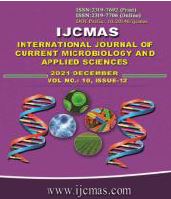


 National Academy of Agricultural Sciences (NAAS)
National Academy of Agricultural Sciences (NAAS)

|
PRINT ISSN : 2319-7692
Online ISSN : 2319-7706 Issues : 12 per year Publisher : Excellent Publishers Email : editorijcmas@gmail.com / submit@ijcmas.com Editor-in-chief: Dr.M.Prakash Index Copernicus ICV 2018: 95.39 NAAS RATING 2020: 5.38 |
The present study investigated the effect of different nutrient management practices on soil C fractions, growth and yield of fodder maize variety- African tall. The treatments were seven in number - T1: POP recommendation, T2: Soil test based POP, T3: Organic nutrient management using TOF-F, T4: POP + AMF, T5: Soil test based POP + AMF, T6: Organic nutrient management + AMF, and T7: Absolute control. Among the soil C fractions, highest TOC content was recorded by T3 which was on par with T5 and T6 and highest DOC content was observed for T1 at both levels of sampling depths. The soil labile and recalcitrant fractions followed same trend at both levels of depth of sampling i.e. T5 was found to be superior which was on par with T6. The highest value for shoot weight, root volume, green fodder and dry fodder yield was observed in treatment T5 which was on par with T4. The root weight was higher for organic nutrient and AMF combination treatment – T6 (50.23 g/plant). The results indicated an increased AMF activity in soil test based and organic manured treatments and inoculation with AMF resulted in better growth and yield of fodder maize in all the treatments. The correlation study indicated a strong positive correlation between labile and recalcitrant soil C fractions and fodder yield of maize giving an insight to the importance those C fractions in microbial growth, nutrient cycling, and plant growth.
 |
 |
 |
 |
 |